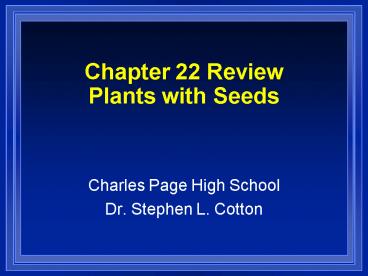Chapter 22 Review Plants with Seeds - PowerPoint PPT Presentation
1 / 15
Title:
Chapter 22 Review Plants with Seeds
Description:
... plant seeds do not include: strawberries; apples; grains of wheat; potatoes ... Flowering trees whose stems grow thicker from year to year are ... – PowerPoint PPT presentation
Number of Views:187
Avg rating:3.0/5.0
Title: Chapter 22 Review Plants with Seeds
1
Chapter 22 ReviewPlants with Seeds
- Charles Page High School
- Dr. Stephen L. Cotton
2
Chapter 22 ReviewPlants with Seeds
- Which of the following reproduce by seeds?
Ferns, gymnosperms, mosses, club mosses - What are the three main organs of a plant?
- Because of the lack of water in the desert, what
type of plants are the only ones that live there?
3
Chapter 22 ReviewPlants with Seeds
- To move substances up and down, a seven-meter
tall tree relies on _______. - The phloem carries food and other substances
which direction? - Vector pollination involves the action of ______.
4
Chapter 22 ReviewPlants with Seeds
- The entire male gametophyte of seed plants is
contained in a tiny structure called a(n)
_______. - A species of conifer that loses its needles
every fall is the _____. - In conifers, the small structures that produce
male and female gametophytes are ______.
5
Chapter 22 ReviewPlants with Seeds
- The huge forest of palmlike plants that the
dinosaurs roamed through were composed of ____. - The term that is least closely related to the
others is flower, fruit, angiosperm, gymnosperm - Which is a dicot? wheat, daisy, orchid, iris
6
Chapter 22 ReviewPlants with Seeds
- Which is a monocot? corn, clover, oak, tomato
- Plant organs that anchor plants into the ground
and absorb water and dissolved nutrients are ___. - How are the vascular bundles arranged in a dicot
stem?
7
Chapter 22 ReviewPlants with Seeds
- Which is least closely related to the others?
Mass extinction of gymnosperms mass extinction
of dinosaurs adaptive radiation of animals
closing of niches - Following the mass extinction of dinosaurs, there
were few new species of ____ plants
8
Chapter 22 ReviewPlants with Seeds
- How are the xylem and phloem arranged in a
monocot root? - Plants do not provide insect pollinators with
what nutrient? - Bees are guided to the source of nectar in a
flower by ____.
9
Chapter 22 ReviewPlants with Seeds
- A common garden plant that springs open and
scatters its seeds when touched is the ___. - An unripe fruit tends to be hidden from animals
by its _____. - Seeds of berries are carried great distances by
birds, because the seeds _____.
10
Chapter 22 ReviewPlants with Seeds
- Male and female reproductive structures in
gymnosperms are called _____. - Unlike a dicotyledon, a monocotyledon has _____.
- You know you are observing a monocot flower if it
has how many petals?
11
Chapter 22 ReviewPlants with Seeds
- Fruits that disperse plant seeds do not include
strawberries apples grains of wheat potatoes - What are some of the functions of a root
structure? - What are the pollinators that lay eggs in the
bodies of dead and decaying animals?
12
Chapter 22 ReviewPlants with Seeds
- Flowering trees whose stems grow thicker from
year to year are _____. - What is the phylum name for ferns and seed
plants? - Is the ginkgo a gymnosperms or angiosperm?
13
Chapter 22 ReviewPlants with Seeds
- The dawn redwood, which dates back 400 million
years, is what type of gymnosperm? - A species of _____ that loses all its needles in
the fall is the bald cypress. - Plants with roots and stems that grow thicker
each year are ____.
14
Chapter 22 ReviewPlants with Seeds
- The ____ are among the few treelike monocots.
- Some very small fruits attach to the ____ of
mammals by sharp barbs. - Leaves with large surfaces have adjustable
openings in the cuticle to help conserve _____.
15
Chapter 22 ReviewPlants with Seeds
- Vector pollination is a process that distributes
seeds away from ______. - Does a plant have to be an angiosperm if it does
not require water for fertilization?

